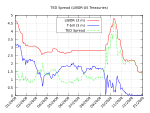File:TED Spread Chart - Data to 9 26 08.png

Original file (960 × 720 pixels, file size: 37 KB, MIME type: image/png)
| This is a file from the Wikimedia Commons. Information from its description page there is shown below. Commons is a freely licensed media file repository. You can help. |

|
File:TED spread 2008.svg is a vector version of this file. It should be used in place of this PNG file when not inferior.
File:TED Spread Chart - Data to 9 26 08.png → File:TED spread 2008.svg
For more information, see Help:SVG.
|
| DescriptionTED Spread Chart - Data to 9 26 08.png |
English: TED Spread and Components - 2008 SummaryThe “TED Spread” is a measure of credit risk for inter-bank lending. It is the difference between: 1) the three-month U.S. treasury bill rate; and 2) the three-month London Interbank Offered Rate (LIBOR), which represents the rate at which banks typically lend to each other. A higher spread indicates banks perceive each other as riskier counterparties. The t-bill is considered "risk-free" because the full faith and credit of the U.S. government is behind it; theoretically, the government could just print money so you will get your principal back at maturity, although there is risk of inflation (e.g., being paid back in cheaper dollars). The TED Spread reached record levels in late September 2008. The diagram indicates that the Treasury yield movement was a more significant driver than the changes in LIBOR. A three month t-bill yield so close to zero means that people are willing to forego interest just to keep their money (principal) safe for three months--a very high level of risk aversion and indicative of tight lending conditions. Driving this change were investors shifting funds from money market funds (generally considered nearly risk free but paying a slightly higher rate of return than t-bills) and other investment types.[1] These issues are consistent with the September 2008 aspects of the subprime mortgage crisis which prompted the Emergency Economic Stabilization Act of 2008 signed into law by the U.S. President on October 3, 2008. In addition, an increase in LIBOR means that financial instruments with variable interest terms are increasingly expensive. For example, mortgages, car loans and credit card interest rates are often tied to LIBOR; some estimate as much as $150 trillion in loans and derivative notional value are tied to LIBOR.[2] ReferencesSourcesThree month treasury bill rates: St. Louis Federal Reserve Bank Three month Libor rates: Bulgarian National Bank Tables Another libor source: BBA |
| Date | |
| Source | Own work (Original text: I created this work entirely by myself.) |
| Author | Farcaster (talk) 03:02, 5 October 2008 (UTC) |
| Other versions | Derivative works of this file: TED Spread Chart - Data to 9 26 08-rebuilt.png |
Licensing
- You are free:
- to share – to copy, distribute and transmit the work
- to remix – to adapt the work
- Under the following conditions:
- attribution – You must give appropriate credit, provide a link to the license, and indicate if changes were made. You may do so in any reasonable manner, but not in any way that suggests the licensor endorses you or your use.
- share alike – If you remix, transform, or build upon the material, you must distribute your contributions under the same or compatible license as the original.

|
Permission is granted to copy, distribute and/or modify this document under the terms of the GNU Free Documentation License, Version 1.2 or any later version published by the Free Software Foundation; with no Invariant Sections, no Front-Cover Texts, and no Back-Cover Texts. A copy of the license is included in the section entitled GNU Free Documentation License.http://www.gnu.org/copyleft/fdl.htmlGFDLGNU Free Documentation Licensetruetrue |
Original upload log
- 2009-01-27 06:16 Farcaster 960×720× (37661 bytes) '
- 2008-11-01 03:38 Farcaster 960×720× (33245 bytes) '
- 2008-10-31 02:54 Farcaster 960×720× (30560 bytes) '
- 2008-10-08 03:42 Farcaster 960×720× (30613 bytes) '
- 2008-10-05 03:02 Farcaster 960×720× (33611 bytes) {{Information |Description= |Source=I created this work entirely by myself. |Date=October 4 2008 |Author=~~~~ |other_versions= }}
Captions
Items portrayed in this file
depicts
4 October 2008
File history
Click on a date/time to view the file as it appeared at that time.
| Date/Time | Thumbnail | Dimensions | User | Comment | |
|---|---|---|---|---|---|
| current | 01:10, 14 October 2010 |  | 960 × 720 (37 KB) | Hideokun | {{Information |Description={{en|TED Spread and Components - 2008<br/> ==Description== The “TED Spread” is a measure of credit risk for inter-bank lending. It is the difference between: 1) the three-month U.S. treasury bill rate; and 2) the three-month |
File usage
The following page uses this file:
Global file usage
The following other wikis use this file:
- Usage on ja.wikipedia.org
Metadata
This file contains additional information, probably added from the digital camera or scanner used to create or digitize it.
If the file has been modified from its original state, some details may not fully reflect the modified file.
| Horizontal resolution | 37.8 dpc |
|---|---|
| Vertical resolution | 37.8 dpc |
| Software used |

